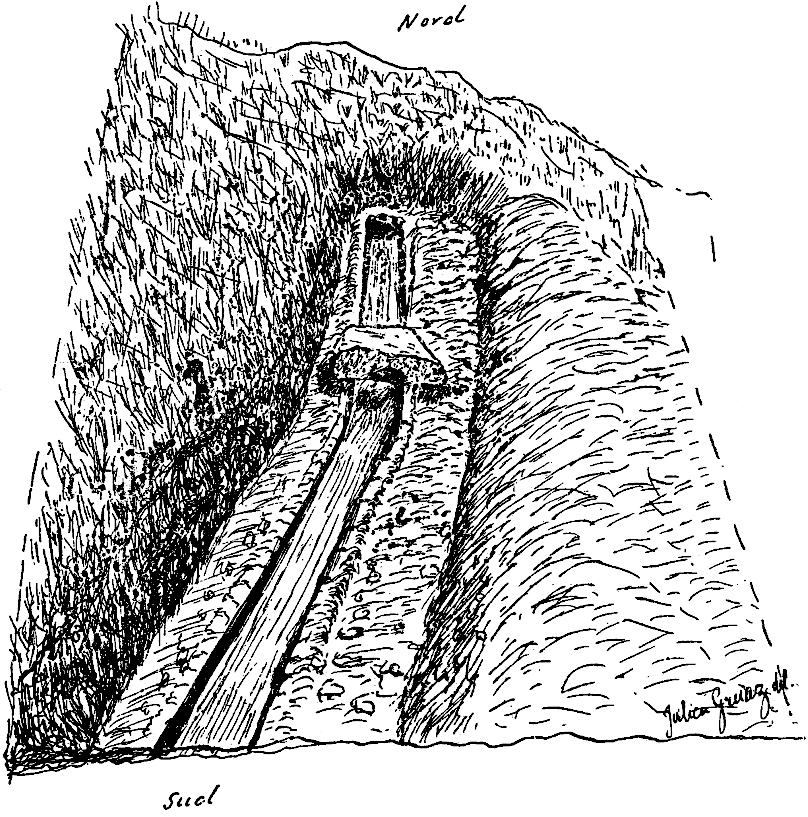|
Introduction The forum The harbour Houses and workshops The surroundings |
In 1894 a few walls were found to the north-east of the settlement that belonged to a theatre, partly excavated further in the 1990's. It had a diameter of 59.50 meters. In 1900 and 1968 a small part was excavated of a building to the north-east of the theatre. It has been called the Villa Contigny-Champ d'Asile. Its main interest lies in a Greek graffito discovered on wall paintings. It is a dactylic hexameter and palindrome (it can be read from left to right and from right to left), and perhaps a reference to the "Deception of Zeus" (Hera seduces Zeus) in book 14 of the Iliad. The same graffito was written three times in the House of Paquius Proculus in Pompei (I.7.1).
[H]ΔH MOI ΔIOC AP'A[ΠATA]
ΠAPA COI ΔIOM[HΔH]Behold then the deception of Zeus
near thee, Diomedes.The Greek graffito from the Villa Contigny-Champ d'Asile.
AP written as AΓ. Kolb et al. 2022, nr. 75. Photo: EDCS-10900270.To the south of the theatre, still to the east of the river Flon (today underground) and to the north-east of the Stade Juan-Antonio-Samaranch, three dedications were found in 1936 and 1937: to Ceres for the well-being of the Caesars (EDCS-10900257) and to the Suleviae, Celtic mother goddesses (EDCS-10900264 and EDCS-10900265). Also to the east of the Flon a bronze sistrum, attribute of Isis, was found in 1936. We have already seen that a bronze votive axe from the western end of the settlement may have been dedicated to Isis-Leusonna. Two fragments of a terracotta relief with Anubis and hieroglyphs are modern, as shown by laboratory research (reported by Marc Duret, curator of the Musée romain de Lausanne-Vidy, in 2023 on Linkedin).
The sistrum found in 1936. H. 0.215. Photo: Musée romain de Lausanne-Vidy on aventicum.org.In 1908 a short stretch of an underground aqueduct was excavated to the north of the settlement. In his brief description from 1910 Julien Gruaz wrote: "Today more than ever it would be desirable if methodical excavations could be carried out in Vidy, if possible every year, even if only for a period of ten to fifteen days. Building contractors and gravel pit operators have begun to establish a foothold in this region".

Sketch of the underground aqueduct. Gruaz, fig. 1.
In 1985 a Gallo-Roman temple was excavated to the west of the settlement. It was built at the end of the first century. The temple was surrounded by an enclosing wall. The square cella (ca. 8 x 8 m.) was surrounded by (wooden?) columns resting on square bases. There was no podium. At a later date three structures were added. One of these invaded the space of the temple, even the cella, so it is difficult to think of a ritual annex of the temple.
Plan of the temple. Paunier et al. 1989, fig. 108.
Reconstruction drawing of the temple. Paunier et al. 1989, fig. 103.A bit to the north-west, in Prilly, or perhaps also in Vidy, a bronze head of a young man and a statuette of Isis-Fortuna were found in 1704. The head must have formed part of a statue. The hairstyle suggests a Trajanic date.
The bronze head from Prilly. Historisches Museum Bern. H. 0.26. Photo: Wikimedia, Sailko.
Introduction
The forum
The harbour
Houses and workshops
The surroundings
[21-Feb-2024]